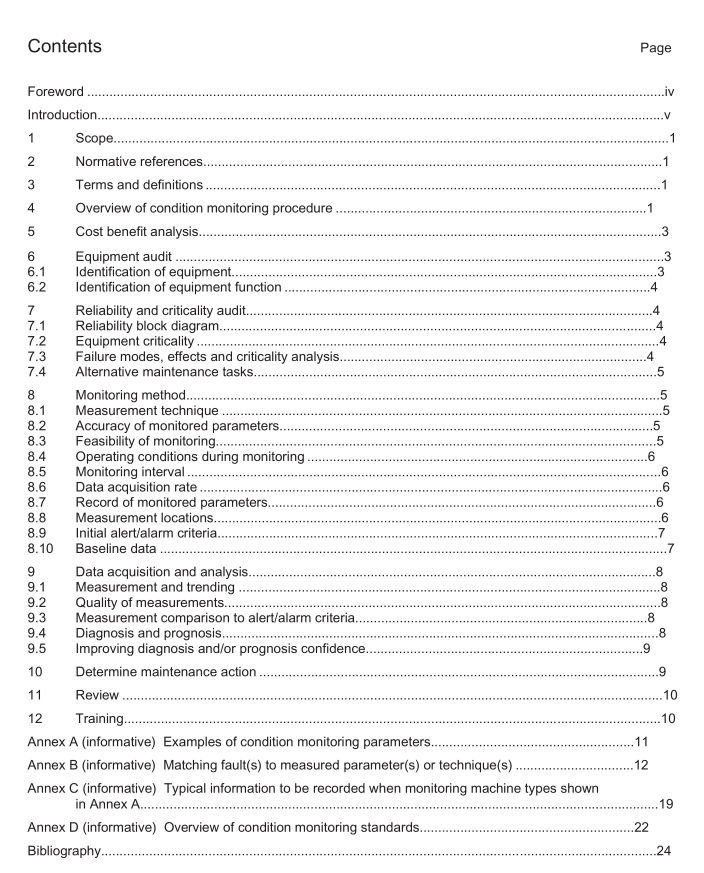BS ISO 17359 pdf download

BS ISO 17359 pdf download Condition monitoring and diagnostics of machines — General guidelines
1 Scope
This International Standard sets out guidelines for the general procedures to be considered when setting up acondition monitoring programme for machines and includes references to associated standards required inthis process. This International Standard applies to all machines.
2Normative references
The following referenced documents are indispensable for the application of this document.For datedreferences,only the edition cited applies. For undated references,the latest edition of the referenceddocument (including any amendments) applies.
ISO 2041,Mechanical vibration, shock and condition monitoring — VocabularyISO 13372,Condition monitoring and diagnostics of machines — Vocabulary
ISO 13379-1,Condition monitoring and diagnostics of machines — Data interpretation and diagnosticstechniques- Part 1: General guidelines1)
ISO 13381-1,Condition monitoring and diagnostics of machines —Prognostics — Part 1: General guidelines
3Terms and definitions
For the purposes of this document, the terms and definitions given in lSO 2041, ISO 13372 and the followingapply.
3.1
equipment
machine or group of machines including all machine or process control components
4Overview of condition monitoring procedure
A generic procedure which may be used when implementing a condition monitoring programme is describedin Clauses 5 to 11 and shown in diagrammatic form in Figure 1. Details on the key steps to be followed areprovided.Condition monitoring activities should be directed towards identifying and avoiding root cause failuremodes.
Particular techniques of condition monitoring are only introduced briefly.They are covered in more detail inother International Standards referenced in Annex D and the Bibliography.
5 Cost benefit analysis
An initial feasibility and cost benefit analysis helps in establishing accurate key performance indicators and benchmarks to measure the effectiveness of any condition monitoring programme. Items to consider include:
life-cycle cost;
cost of lost production;
consequential damage;
warranty and insurance.
6 Equipment audit
6.1 Identification of equipment
A generic machine schematic of the typical components and processes to be considered in the condition monitoring management process is shown in Figure 2.
6.2ldentification of equipment functionldentify the following information:
what is the system, machine or equipment required to do?
what are the machine or system operating conditions or range of operating conditions?7Reliability and criticality audit
7.1 Reliability block diagram
lt can be useful to produce a simple high-level reliability block diagram , including whether the equipment has aseries or parallel reliability effect. The use of reliability and availability factors is recommended to improve thetargeting of the condition monitoring processes.
Detailed information on producing reliability block diagrams is contained in references in the Bibliography.
7.2Equipment criticality
A criticality assessment of all machines is recommended in order to create a prioritized list of machines to beincluded (or not) in the condition monitoring programme.This may be a simple rating system based on factorssuch as:
cost of machine down-time or lost production costs;failure rates and mean time to repair;
redundancy;
consequential or secondary damage;replacement cost of the machine;cost of maintenance or spares;life-cycle costs;
cost of the monitoring system;safety and environmental impact.
One or more of the above factors may be weighted and included in a formula to produce the prioritized list.The results of this process may be used when selecting methods of monitoring (see Clause 8)
7.3Failure modes, effects and criticality analysis
lt is recommended that a failure modes and effects analysis (FMEA) or failure mode effect and criticalityanalysis (FMECA) be performed in order to identify expected faults, symptoms and potential parameters to bemeasured which indicate the presence or occurrence of faults.









